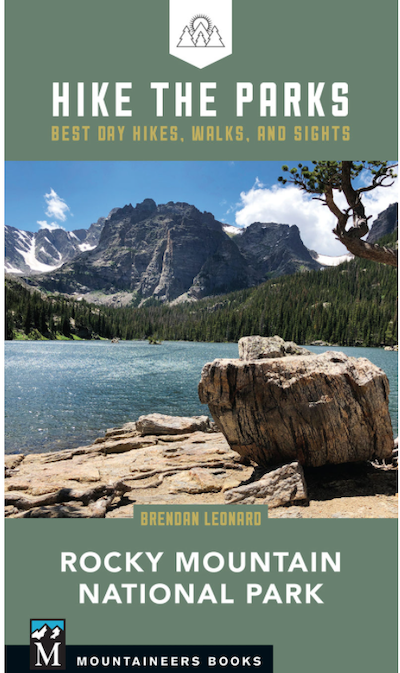
Labor Day Weekend is in sight, which means there soon should be a big drop off in visitation to Rocky Mountain National Park and other parks in the National Park System. And that means folks not tied to the school calendar should be getting ready to head out into the parks.
If you're planning on visiting Rocky Mountain and hope to do some hiking, there's a new guidebook that can help you craft an itinerary for best day hikes. The book, Hike The Parks | Best Day Hikes, Walks, and Sights: Rocky Mountain National Park from Mountaineers Books, is small, roughly 7 inches by 4 inches, but it's packed with hikes broken down into four sections of the park.
The sections identified by author Brendan Leonard are the Grand Lake Entrance, Trail Ridge Road, Bear Lake Road, Devil's Gulch Road, and Colorado Highway 7, a breakdown that makes it easy to find hikes depending on the entrance you use to visit Rocky Mountain and want to hit the trail as soon after you reach the park as possible.
The Bear Lake Entrance, because of its popularity, offers the most hikes in the guide, with 13. They range from the simple hike around the lake, one that is good for younger children as it's not too long -- eight-tenths of a mile, and with very little gain or drop in elevation (50 feet) -- to the much more challenging hike to Flattop Mountain and Hallet Peak. That's a ten-mile round trip that comes with a 3,250-foot gain in elevation from the Bear Lake parking lot.
Leonard's use of a "Hikes At A Glance" chart in the front of the book makes it easy to quickly dispense with hikes that you might consider too short or too long and hard. Here he lists the hikes by name, distance, elevation gain, high point in elevation, and difficulty level (easy, medium, or hard).
True, difficulty levels can be pretty subjective, so looking at the distance and gain in elevation should quickly help you decide whether it's a journey you want to take. And, of course, if you're coming from sea level or somewhere near that elevation, the high point listed for each hike could be a deciding factor if you don't have time to acclimate to Rocky Mountain's elevations.
The author also tosses in a cursory section on the park's natural history (flora and fauna), campground information, park regulations (leave your drone at home), and safety issues. If you're interested in Rocky Mountain's natural history, there are books that go much more detail in that aspect of the park. He also suggests itineraries for one- and three-day stays in the park.
Something to keep in mind if a visit to Rocky Mountain is planned for the coming months or even next spring is that two pretty large wildfires burned parts of the park in 2020, and so a trail you might want to tackle might not be open yet (most of these are on the western side of the park). Be sure to check with a park visitor center before you drive to the trailhead.
This is a good handy book to have for exploring day hikes in Rocky Mountain, and it's small enough to slip into your daypack, something that's always nice to be able to do with a guidebook.
Another great book to take along to the park with you is The Rocky Mountain Reader. Through its nearly 280 pages James H. Pickering has masterfully assembled narratives crafted from those who homesteaded the land within today’s park, from naturalists such as Anne Zwinger, Stephen Trimble, SueEllen Campbell, and even from mountain climbers.
There are other “readers” (on Grand Canyon National Park, Yellowstone National Park, and the Pacific Crest Trail, for example), but this title has a preponderance of late 19th century—not 20th century—articles. Released by the University of Utah Press back in 2017, this book is a particularly rich and entertaining read that helps us understand how this rugged landscape was viewed, used, and appreciated before it became a national park in 1915.



Add comment